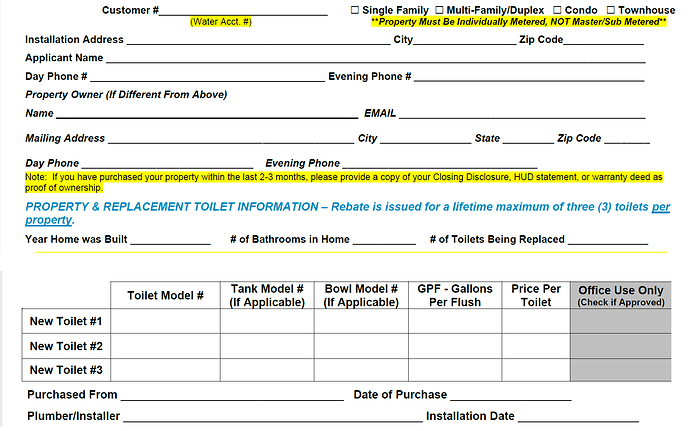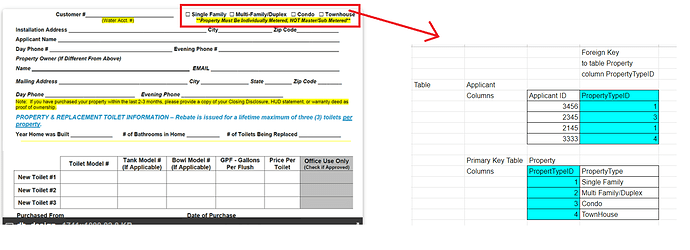The great Scott Pletcher helped me with this here:
Despite his incredible help, I am still having issues stringing everything together.
I thought it would be more helpful to just start from the original document the user presented to the original designer.
Here is screenshot.
I know that I can create a one to many relationship between the applicant (Onwer) and the Toilets (Toilet 1 through 5). The screenshot showed 3 but two have been added since the original design.
The question is how do I relate the applicant info with toilets and the toilet model info?
As always, any assistance is greatly appreciated.
Here is the form that applicants are given to complete and the DB design is developed from this form.
This is what I am able to put together based on the screenshot above:
Table: Applicants
ApplicantID int IDENTITY(1,1) NOT NULL,
CustomerAcctNo DECIMAL(9, 2) NOT NULL,
ApplicantFirstName VARCHAR(50) NOT NULL,
ApplicantLastName VARCHAR(50) NOT NULL,
ApplicantMI VARCHAR(5),
InstallAddress VARCHAR(150),
City VARCHAR(50),
State VARCHAR(50),
ZipCode VARCHAR(5),
DayPhone VARCHAR(12),
EveningPhone VARCHAR(12),
IsPropertyOwner bit,
OwnerFirstName VARCHAR(50),
OwnerLastName VARCHAR(50),
OwnerMI VARCHAR(50),
OwnerEmail VARCHAR(5),
MailingAddress VARCHAR(150),
City VARCHAR(50),
State VARCHAR(50),
ZipCode VARCHAR(5),
OwnerDayPhone VARCHAR(12),
OwnerEveningPhone VARCHAR(12),
YearHomeBuilt int,
NoOfToilets int,
NoOfToiletsToReplace int
Table: Toilets
ToiletID int IDENTITY(1,1) NOT NULL,
ApplicantID int NOT NULL, --FK to Applicants table
GPFID int NOT NULL, --FK to ToiletGPF table
ToiletModelNo VARCHAR(50) NOT NULL,
TankModelNo VARCHAR(50),
BowlModelNo VARCHAR(50)
Table: ToiletGPF - Lookup table
GPFID int IDENTITY(1,1) NOT NULL,
GPF DECIMAL(9, 2) NOT NULL,
Rebate DECIMAL(3, 2) NOT NULL
Any recommendations for additional changes greatly appreciated.





